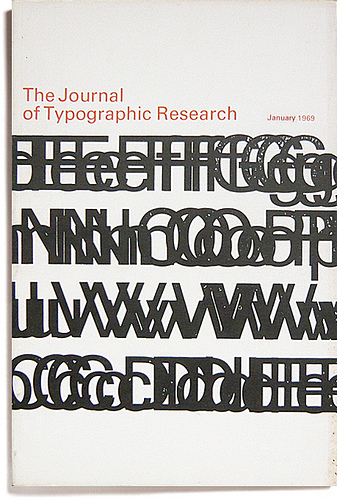Merald Wrolstad: The Journal of Typographic Research, 1967.
1969

2002

“Visible Language” has been existing for almost 50 years and, according to Poggenpohl and Zender, change is a natural consequence of this long a history. The journal was founded in 1967, and back then it was called “The Journal of Typographic Research”. The first editor, Merald Wrolstad was the one to establish the journal, change its name, and guide it through 20 years of successful publishing with “a focus on reading and writing, the processing of visible language (reading) and its construction” (Poggenpohl and Zender 6).
Second Generation
The second generation in the life of “Visible Language” was marked by the appointment of a new editor, Sharon Poggepohl. For twenty-six years, she guided the journal while attempting to build an inclusive platform for research and “various forms of scholarship” as well as “bridge the gap between research and art” (Poggenpohl and Zender 6). As a result, the works of both broad and narrow scope related to theory as well as practice conducted through various classic and more innovative methods could find a place in the journal. Sharon Poggenpohl was also the one to introduce the journal to the digital age with the help of the Institute of Design at the Illinois Institute of Technology.
Third Generation
Now, as the third editor, Paul Michael Zender begins to work with the Journal, “Visible Language” appears to be preparing for the change again. The University of Cincinnati is becoming the new institutional support of the Journal. The University demonstrates an acute interest in research and practices cooperative education that is based on the inclusion of academic and practical experiences. Similarly, Mike Zender expresses the intention of “advancing design through research”, and these factors might shape the new form of “Visible Language (Poggenpohl and Zender 9).
Change and Stability
As Poggenpohl and Zender point out, for a design journal transition and change are only natural. And yet, “Visible Language” promises to stay “true” to its traditions by keeping to its topic of visual communication, including “perception, symbols, 3-D objects, user experiences, contexts and interactive systems” (Poggenpohl and Zender 10). The editors believe that the inclusive nature of the journal will be preserved as well as its role of encouraging research in the field of visual communication and design.
In general, the editors believe that, given the importance of visual information, Visible Language has a bright future that can only be compared to its rich history.
Works Cited
Poggenpohl, Sharon, and Paul Michael Zender. “Visible Language in Transtition.” Visible Language 47.1 (2013): 5-10. Print.
